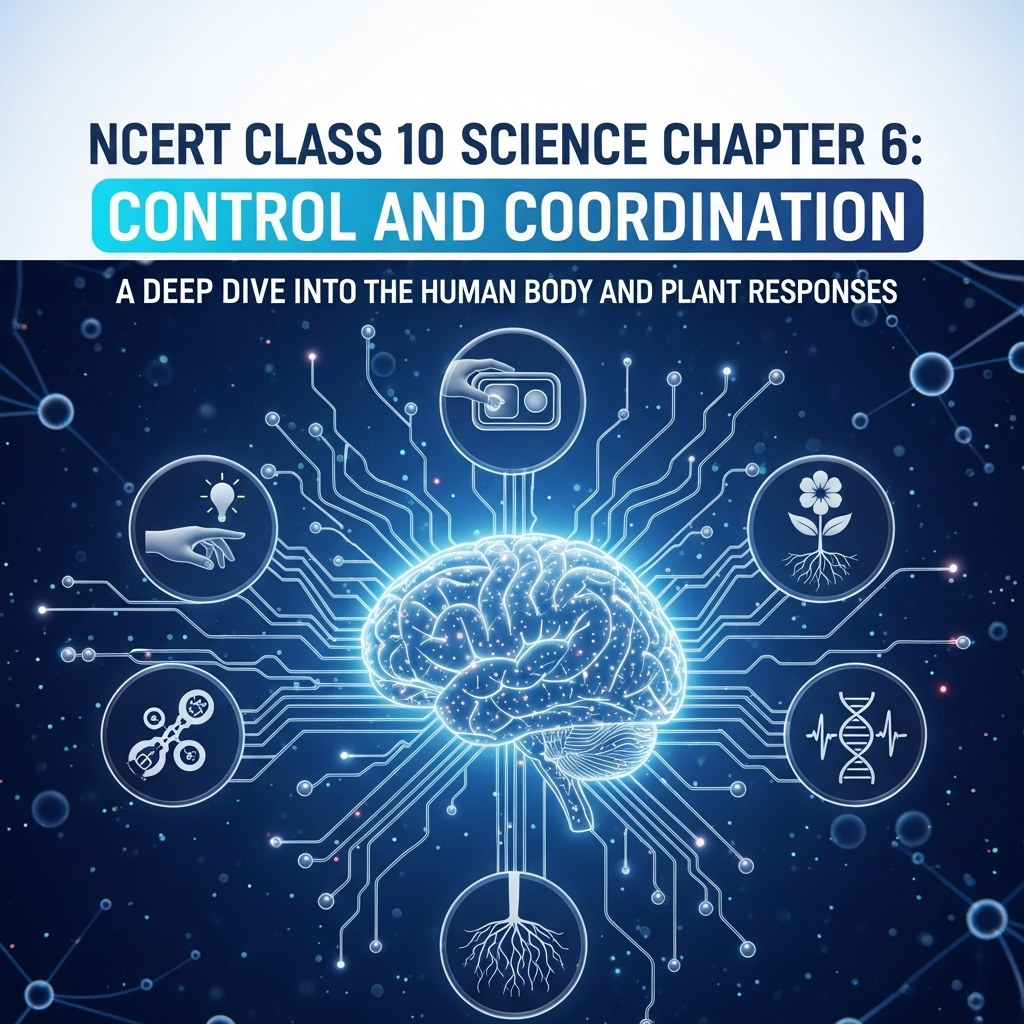Complete Solutions and Summary of Control and Coordination – NCERT Class 10, Science, Chapter 6 – Summary, Questions, Answers, Extra Questions
Comprehensive summary and explanation of Chapter 6 'Control and Coordination,' covering nervous system in animals, structure and function of neurons, reflex actions, brain regions and their functions, coordination in plants including tropic movements, plant hormones, chemical coordination in animals via hormones, feedback mechanisms, and practical exercises—paired with all question answers and extra questions from NCERT Class X Science.
Updated: 2 months ago
Categories: NCERT, Class X, Science, Biology, Summary, Extra Questions, Nervous System, Reflex Actions, Brain Functions, Plant Movements, Hormones, Chemical Coordination, Chapter 6

Control and Coordination
Chapter 6: Science - Complete Study Guide | NCERT Class 10 Notes & Questions 2025
Comprehensive Chapter Summary - Control and Coordination Class 10 NCERT
Overview
- Chapter Purpose: Explains control/coordination in organisms. Links to life processes. Exam Tip: Focus on diagrams, activities, hormones. Expanded Relevance 2025: Neuroscience applications. Do You Know: Reflex arcs in sports. Figures: Neuron, reflex arc, brain, endocrine glands. Key Insight: Controlled movements essential. Conservation: Hormonal balance in ecosystems.
- Broader Implications: Response to environment, survival, health.
Introduction: Movement and Life
- Movements indicate life: Growth-related (seedling pushes soil) or non-growth (cat running, children swinging, buffaloes chewing).
- Association with life: Response to environmental changes (cat sees mouse).
- Advantage: Use changes for benefit (plants to sunshine, pleasure from swinging, better digestion).
- Protection: Detect/respond to stimuli (bright light, hot object) via movement.
- Controlled movement: Depends on trigger; requires recognition/coordination.
- Systems: Specialized tissues in multicellular organisms for control/coordination.
6.1 Animals – Nervous System
- Provided by nervous/muscular tissues (from Class IX).
- Detection: Specialized nerve cell tips (receptors) in sense organs (ear, nose, tongue).
- Examples: Gustatory (taste), olfactory (smell).
- Impulse generation: Dendritic tip chemical reaction → electrical impulse.
- Travel: Dendrite → cell body → axon → end (releases chemicals across synapse).
- Synapse: Gap; starts impulse in next neuron.
- Delivery: To muscles/glands.
- Neuron network: Conducts information via impulses.
- Parts: (i) Dendrite (acquire), (ii) Axon (travel), (iii) Axon end (chemical signal).
6.1.1 What Happens in Reflex Actions?
- Reflex: Sudden action without thinking (jump from bus, pull hand from flame, mouth watering).
- Control: Without conscious thought; quick response to environment.
- Example: Touching flame → think pain/burn → move hand (time-consuming).
- Thinking: Complex; many neuron interactions in brain (dense networks).
- Brain: Receives/integrates signals; sends to muscles.
- Problem: Time for burn if via brain.
- Solution: Reflex arc – simpler connection (heat-detecting nerves to muscle nerves).
- Location: Spinal cord (nerves bundle).
- Evolution: Quick; animals without complex thinking use; remains efficient.
- Sequence for bright light on eyes: Detect → reflex arc → response.
6.1.2 Human Brain
- Not only reflex: Thinking beings; spinal cord supplies info to brain.
- CNS: Brain + spinal cord; receive/integrate info.
- Voluntary actions: Decide (writing, talking, moving chair, clapping).
- Communication: CNS to body via PNS (cranial/spinal nerves).
- Brain design: Complex; parts for inputs/outputs.
- Regions: Fore-brain (thinking; sensory areas for hearing/smell/sight; association interprets; motor controls voluntary muscles; hunger center).
- Mid-brain/hind-brain: Involuntary (blood pressure, salivation, vomiting by medulla).
- Cerebellum: Precision/posture/balance (walking, riding, picking).
6.1.3 How Are These Tissues Protected?
- Brain: In bony box (skull); fluid-filled balloon for shock absorption.
- Spinal cord: Vertebral column (backbone; feel hard/bumpy).
6.1.4 How Does the Nervous Tissue Cause Action?
- Process: Collect/send/process/decide/convey to muscles.
- Muscle movement: Nerve impulse reaches → fibre changes shape/shortens.
- Mechanism: Special proteins change shape/arrangement via impulses.
- Muscle types: Voluntary/involuntary (differences from Class IX).
6.2 Coordination in Plants
- No nervous/muscles: Respond to stimuli (touch-me-not folds, seedling direction).
- Types: Growth-independent (quick leaf fold) vs growth-dependent (no movement if prevented).
6.2.1 Immediate Response to Stimulus
- Sensitive plant: Quick leaf movement; no growth.
- Detection: Touch point ≠ movement point; info communicated.
- Means: Electrical-chemical (no specialized tissue).
- Movement: Cells change shape via water amount (swell/shrink).
6.2.2 Movement Due to Growth
- Tendrils: Sensitive; contact side grows less → circles/clings.
- Tropic movements: Directional (towards/away stimulus).
- Phototropism: Shoots to light, roots away.
- Geotropism: Roots down, shoots up (gravity).
- Hydrotropism: To water; Chemotropism: Chemicals (pollen tube to ovule).
- Activity 6.2: Bean seeds bend to light; roots away.
6.3 Hormones in Animals
- Chemical transmission: For wide changes (fight/flight in squirrel).
- Adrenaline: From adrenals; to blood; heart faster, more O2 to muscles; reduce blood to digestion/skin; increase breathing.
- Endocrine system: Second control way.
- Activity 6.3: Identify glands (Fig. 6.7).
- Plant hormones: Control directional growth.
- Animal growth: Controlled (no directional like plants).
- Examples: Iodine for thyroxin (metabolism; goitre if deficient).
- Growth hormone: Pituitary; deficiency → dwarfism.
- Puberty: Testosterone (males), oestrogen (females).
- Insulin: Pancreas; diabetes if low (injections).
- Feedback: Regulates amount (e.g., insulin on sugar levels).
- Table 6.1: Hormones/glands/functions.
SEO Note: Why This Guide?
Top-ranked for 'Control and Coordination Class 10 notes 2025'—free, with 60 Q&A from PDF, quizzes. Integrates nervous system, plants, hormones.
Key Themes
- Control: Nervous/hormonal.
- Reflex: Quick protection.
- Brain: Thinking/involuntary.
- Plants: Tropisms/hormones.
- Hormones: Chemical messengers.
Cases for Exams
Explain reflex arc; brain parts; plant tropisms; hormonal disorders.
Exercises Summary
- Focus: Expanded to 60 Q&A: 20 short (1M), 20 medium (4M), 20 long (8M) based on NCERT + similar.
- Project Idea: Model neuron; test plant responses. Group Activity: Reflex simulation.
Group Discussions
No forum posts available.


